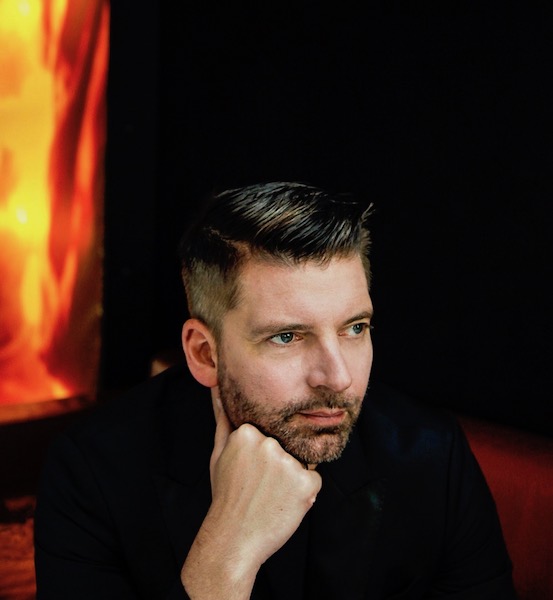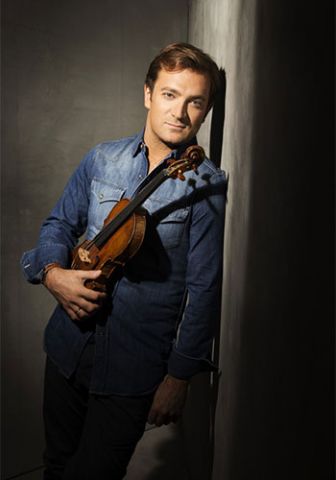Pintscher, New World deliver whirling colors and rapt beauty in outstanding contemporary program
Matthias Pintscher has become a regular presence at the New World Symphony’s Sounds of the Times series. And, judging by the rousing welcome Pintscher received Saturday night at New World Center, the German composer-conductor has become a favorite of the mostly youthful audience these adventurous programs draw.
Amid the bracing menu of modern works, the evening’s best score was Pintscher’s own mar’eh, a violin concerto in everything but name.
In Hebrew the title means “face” or “sign” or “the aura of a beautiful vision.” Complex, atonal, yet still romantic in a thoroughly 21st-century manner, Pintscher’s score is indeed beautiful. Yet this is not a virtuosic showpiece and the 27-minute work is mostly slow and quiet. Even though it is scored for a large orchestra, Pintscher rarely utilizes the entire ensemble at full force.
The score’s opening bars for solo violin are soft nearly to the point of inaudibility. There are long, sustained lines for the soloist in the instrument’s highest register. The orchestra provides a continual stream of varied timbres in a sound world of almost impressionistic hues. Solo horn and combinations of piano and harp offer counter figures and there is a haunting English horn solo. Throughout the work, Pintscher establishes a contemplative mood, interrupted only by a few tumultuous climaxes. The final fading bars seem to sound from afar. This is a major score that deserves wide exposure.
Originally conceived in 2010 for Julia Fischer, mar’eh proved a perfect vehicle for Renaud Capuçon. The French violinist plays the 1773 Guarneri del Gesú instrument that previously belonged to Isaac Stern, and Capuçon’s subtle artistry drew out the glistening harmonics and rich tonal hues of the score. Pintscher was an outstanding collaborator, blending the instrumental textures and solo lines with supple and consummate skill. John Wilson’s piano and Chloe Tula’s harp added spice to the orchestral palette and the hard-working percussion section deserves special praise. Capuçon and Pintscher were cheered by the audience for their dedicated performance.
Olga Neuwirth’s Masaot/Clocks Without Hands was clearly meant to be a crowd pleaser but emerged as something less. Masaot is the Hebrew word for “journey” and the Austrian composer wrote that the work was based on a dream about her grandfather, who she never knew, playing songs on a crackling tape recorder that overlapped with his own journey through life.
Amid a blaze of diffuse, often loud orchestral colors, Neuwirth creates a jumble of Balkan motifs and band fanfares. As a short overture, this hodgepodge of orchestral tumult and folk influences might work, but at 25 minutes in length, it is hopelessly bloated and coarse. Pintscher really put the New World players through their paces, bringing more precision of detail and whipcrack energy to the music than it deserved. Jesse McCandless’s high clarinet solo burst forth with spectacular brilliance amid the din.
The concert opened with György Ligeti’s San Francisco Polyphony. Written in 1973 for the 60th anniversary of the San Francisco Symphony, the score offers Ligeti’s dense, layered musical cells, which transform into new units at every turn. The composer’s avant garde aesthetic takes on a neo-Baroque sensibility and the score’s 12-minute duration is packed with terse thematic fragments. Mood swings from sprightly to reflective to fierce harshness alight the constantly changing whirl of sounds.
Pintscher kept the overlapping textures transparent and astutely commanded the constant changes of tempo. Hopping between piano and celesta, Thomas Stiegerwald added percussive bursts to Ligeti’s minutely constructed patterns. Ligeti’s wide-ranging ensemble includes three flutes and muted tuba and all the players were on top of the music all the way. Indeed the New World musicians gave performances of dazzling corporate power and propulsion to all the scores on this challenging program.
Michael Tilson Thomas conducts the New World Symphony 7:30 p.m. February 23 and 2 p.m. February 24 at New World Center in Miami Beach. The program includes Bach’s Brandenburg Concerto No. 3, Dvořák’s Symphony No. 8 and Ligeti’s Violin Concerto with soloist Christian Tetzlaff. Dean Whiteside conducts Smetana’s Overture to The Bartered Bride. nws.edu; 305-673-3331.
Posted in Performances
One Response to “Pintscher, New World deliver whirling colors and rapt beauty in outstanding contemporary program”
Leave a Comment
Sun Feb 17, 2019
at 12:29 pm
1 Comment







Posted Feb 19, 2019 at 4:02 pm by Bill
Bartolomeo Giuseppe Guarneri “del Gesù” died in 1744. The violin of his played by Stern, known as the “Panette” after a French noble of that name who purchased it in the mid-19th century, dates from 1737, not 1773. This was not the only violin by “del Gesù” owned and used by Stern, who also played on the “Ysayë” of 1740, alternating with the “Panette” to allow the instruments to “rest” as he felt necessary.